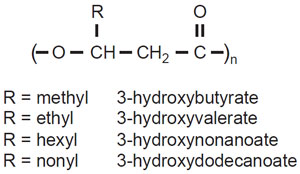PHA As a Bacterial Polyester
PHAs have been detected in over 90 genera of bacteria, including Gram-positive
and Gram-negative species, as well as some cyanobacteria (Kim and Lenz,
2002; Steinbu¨ chel and Hein, 2001). While the majority of PHAs are composed of
monomers of R-(—)-3-hydroxyalkanoic acid ranging from 3 to 16 carbons in length
(C
3–C
16) (Fig. 8.3), some PHAs can also incorporate 4-, 5-, or 6-hydroxy acids
(Steinbu¨ chel and Valentin, 1995). Nearly 150 different hydroxyacids have been
found incorporated in bacterial PHAs, with the major diversity being found in the
length and the presence of functional groups in the side–chains of the polymer
(Steinbu¨ chel and Valentin, 1995). Although some of these monomers have been
found in PHA produced by bacteria in their natural environment, a larger fraction
of monomers have been incorporated into PHA following growth of bacteria in artificial media containing exotic sources of carbon, such as fatty acids with
double or triple bonds.
Bacteria synthesizing PHAs have been broadly subdivided in two groups. One
group, including the bacterium
Ralstonia eutropha, produces short-chain-lengthPHA
(SCL-PHA) containing monomers ranging from 3 to 5 carbons in length, while
a second group, including a number of Pseudomonads, synthesizes medium chain
length-PHA (MCL-PHA) containing monomers ranging from 6 to 16 carbons in
length. This division
 |
| FIGURE 8.3 Chemical structure of
polyhydroxyalkanoate. The monomers can range
from
3 to 16 carbons in length, depending on the
size of the pendant R group. |
between SCL- and MCL-PHA is mainly determined by the
substrate specificity of the PHA synthase responsible for the polymerization of the
substrate R-3-hydroxyacyl-CoA to form PHA. This division between SCL- and
MCL-PHA is however not strict, since several bacteria have been found that can
synthesize a ‘‘hybrid’’ PHA that can include monomers from 4 to 8 carbons (Fukui
and Doi, 1997).
A number of enzymes and metabolic pathways have been implicated in the
synthesis of a spectrum of PHAs in bacteria. In this chapter, we wish to focus
only on the pathways that have been successfully transferred in plants. The
readers are referred to several excellent reviews to learn more on various aspects
of bacterial PHA, including biochemical synthesis and application of PHAs
(Anderson and Dawes, 1990; Braunegg
et al., 1998; Steinbü chel, 1991; Steinbü chel
and Fü chtenbusch, 1998; Steinbü chel and Lu¨ tke-Eversloh, 2003; Steinbü chel and
Schlegel, 1991; Sudesh and Doi, 2000; van der Walle
et al., 2001).





